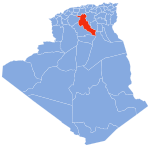Djelfa
This article needs additional citations for verification. (June 2015) |
Djelfa
الجلفة | |
|---|---|
 | |
| Country | |
| Province | Djelfa Province |
| District | Djelfa District |
| Population (2008) | |
| • Total | 339,248 |
| Time zone | UTC+1 (CET) |
Djelfa (Arabic: الجلفة) is the capital city of Djelfa province, Algeria. It has a population of 339,248 (2008 census). The city lies at the junction of the N1 and the N46.
Geography
It is a pleasant medium-size city, north-central Algeria, in the Ouled Nail Mountains at an elevation of 3,734 feet (1,138 m). It is situated between the towns of Bousaada and Laghouat. Djelfa town is at a point of transition between the dry, steppelike High Plateaus of the north, with their chotts (intermittent salt lakes), and the Sahara (south). The town was founded in 1852 as a French military post on a geometric plan. It serves as an important livestock market centre for the seminomadic Ouled Nail confederation. Djelfa is on the 12,000 mile Africa Trail.

The surrounding region for centuries has been the meeting place of the Ouled Naïl people, who live in black-and-red striped tents and claim descent from the Islamic prophet, Muhammad.
The area is notable for its abundance of Neolithic rock carvings dating from 7000 to 5000 BC. North of Djelfa town there is an imposing physical feature known as Salt Rock (Rocher de Sel) that resulted from the erosion of rock salts and marls by rain. To the west of the town Megalithic funerary structures are found.
- See separate article, Rock art of the Djelfa region.
During Philippe Pétain's period, a concentration camp was placed in Djelfa.[1]
History
The inhabitants descended from Ouled Nail, an Arab tribe also operates in Biskra or M'Sila and in Saharan Atlas.
Climate
Djelfa has a semi-arid climate (Köppen climate classification BSk), with hot, fairly dry summers and cool, somewhat moist winters. Snow is not unusual in winter.
| Climate data for Djelfa | |||||||||||||
|---|---|---|---|---|---|---|---|---|---|---|---|---|---|
| Month | Jan | Feb | Mar | Apr | May | Jun | Jul | Aug | Sep | Oct | Nov | Dec | Year |
| Record high °C (°F) | 22.0 (71.6) |
25.5 (77.9) |
29.3 (84.7) |
33.2 (91.8) |
38.4 (101.1) |
39.6 (103.3) |
41.8 (107.2) |
39.2 (102.6) |
37.0 (98.6) |
38.0 (100.4) |
28.8 (83.8) |
24.5 (76.1) |
41.8 (107.2) |
| Mean daily maximum °C (°F) | 9.8 (49.6) |
11.4 (52.5) |
14.1 (57.4) |
18.1 (64.6) |
23.1 (73.6) |
29.3 (84.7) |
33.7 (92.7) |
32.6 (90.7) |
27.5 (81.5) |
20.4 (68.7) |
14.4 (57.9) |
10.8 (51.4) |
20.4 (68.8) |
| Daily mean °C (°F) | 5.0 (41.0) |
6.4 (43.5) |
8.3 (46.9) |
11.9 (53.4) |
16.3 (61.3) |
22.0 (71.6) |
25.7 (78.3) |
24.9 (76.8) |
20.4 (68.7) |
14.3 (57.7) |
9.1 (48.4) |
5.9 (42.6) |
14.2 (57.5) |
| Mean daily minimum °C (°F) | 0.1 (32.2) |
1.4 (34.5) |
2.3 (36.1) |
5.7 (42.3) |
9.5 (49.1) |
14.7 (58.5) |
17.6 (63.7) |
17.1 (62.8) |
13.2 (55.8) |
8.2 (46.8) |
3.8 (38.8) |
1.0 (33.8) |
7.9 (46.2) |
| Record low °C (°F) | −12.0 (10.4) |
−9.0 (15.8) |
−7.2 (19.0) |
−3.9 (25.0) |
0.3 (32.5) |
3.6 (38.5) |
9.0 (48.2) |
8.0 (46.4) |
2.0 (35.6) |
0.0 (32.0) |
−11.0 (12.2) |
−8.0 (17.6) |
−12.0 (10.4) |
| Average precipitation mm (inches) | 33.4 (1.31) |
32.4 (1.28) |
38.1 (1.50) |
30.8 (1.21) |
36.1 (1.42) |
29.7 (1.17) |
9.4 (0.37) |
18.6 (0.73) |
25.7 (1.01) |
25.1 (0.99) |
37.2 (1.46) |
30.9 (1.22) |
347.4 (13.67) |
| Average relative humidity (%) | 72.9 | 66.8 | 58.0 | 53.9 | 47.3 | 36.5 | 30.3 | 33.8 | 49.0 | 57.3 | 69.1 | 77.2 | 54.3 |
| Source 1: NOAA (1972-1990)[2] | |||||||||||||
| Source 2: climatebase.ru (extremes, humidity)[3] | |||||||||||||
References
- ^ http://www.apra.asso.fr/Camps/En/Camp-Djelfa.html
- ^ "Climate Normals for Djelfa". Retrieved 11 February 2013.
- ^ "Djelfa, Algeria". Climatebase.ru. Retrieved 11 February 2013.


